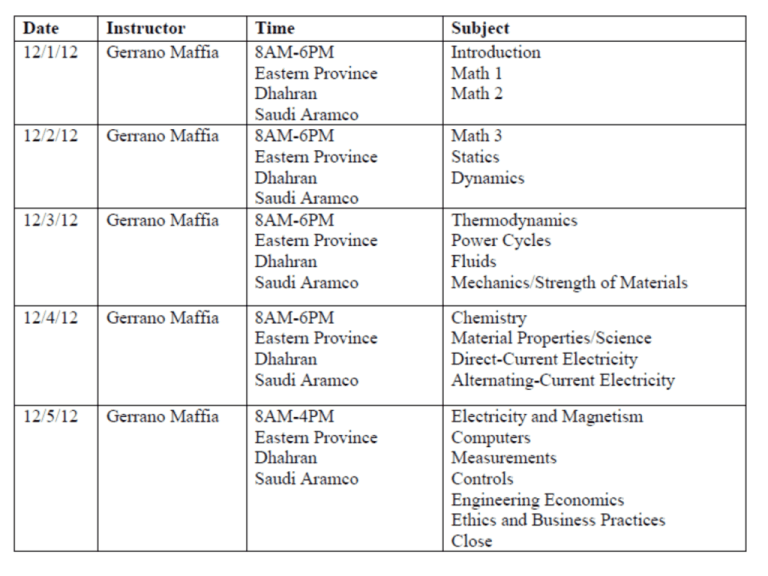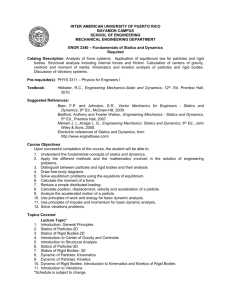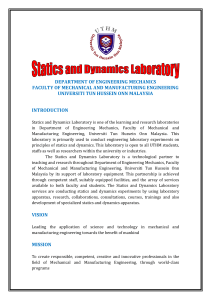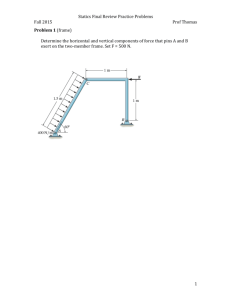Day 2
advertisement

Exam Specifications Mathematics Engineering Probability and Statistics Chemistry Computers Ethics and Business Practices Engineering Economics Statics and Dynamics Strength of Materials Material Properties Fluid Mechanics Electricity and Magnetism Thermodynamics 15% 7% 9% 7% 7% 8% 10% 7% 7% 7% 9% 7% BEGINNING OF PROBABILITY AND STATISTICS Problem 20 TOPIC: Probability and Statistics (page 40) Please calculate the mean, median, and mode of the following data: 1,1,3,4,1,2,1,3,4,5,5,6,1 (a) mean (b) median (c) mode Problem 21 TOPIC: Probability and Statistics (page 40) Please calculate the variance, standard deviation and geometric mean of the following data: 1,1,3,4,1,2,1,3,4,5,5,6,1 (a) variance (b) standard deviation (c) geometric mean Problem 22 TOPIC: Probability and Statistics (page 40) An engineering contractor has a staff of 10 engineers, all equally qualified. For a particular assignment 3 engineers are required. (a) Calculate the number of permutations of engineers that could be assigned to the work. (b) Calculate the number of combinations of engineers that could be assigned to the work. Problem 23 TOPIC: Probability and Statistics (page 41) An assembly plant operates three lines with the following production data: Line A B C % production 50 35 15 fraction defective 0.02 0.015 0.04 (a)Assuming that you have a defective item, what is the probability that it was produced by line C? (b) What is the probability of having a defective item? Problem 24 TOPIC: B A 2 5 1 Probability and Statistics (page 40) 8 3 C 9 4 10 7 11 6 D Please find the following (a) Find A B (c) Find (A B) C (b) Find A B (d) Find A B C D (e) Find (A B) (C D) (f) Find B C (g) Find A B (h) Find A B (i) Find A B D (j) Find A B D Problem 25 TOPIC: Probability and Statistics (page 40) A petrochemical plant makes the following breakdown of products with the data based on a carbon balance: Carbon Number 1-2 3-4 5-7 8-12 >12 % produced 35 35 12 9 9 Please find the following probabilities: (a) Probability of producing products with a carbon number greater than 4 (b) Probability of producing products with a carbon number greater than 4 and less than 13 (c) Probability of producing products with a carbon number less than 13 (d) Probability of producing products with a carbon number greater than 7 Problem 26 TOPIC: Probability and Statistics (page 41) Please find the following cumulative distribution functions F(x) given the probability density functions, f(x): (a) f ( x) x; with 0 x 2 (b) f ( x) x 2 ; with 0 x 3 3 (c) f ( x) x; with 0 x 2 (d) Please find the mean value of the function in part (a) Problem 27 TOPIC: Probability and Statistics (page 42-46) A set of ethylene yield data are normally distributed with mean of 24.7 and a variance of 5; that is Y~N(24.7,5) (a) Find the probability that the yield is less than 24. (b) Find the probability that the yield is greater than 26 (c) Find the probability that the yield is between 25 and 26. (d) Find a 95% confidence interval for this yield data assuming that 25 data points have been taken. (e) Find a 95% confidence interval assuming that the variance is not known but that the sample size is 25 and the mean is 24.7 and the sample variance is 5. Problem 27 TOPIC: Probability and Statistics (page 226) A set of ethylene yield data are collected; 24.1, 25.1, 24.3, 24.6, 24.9 (a) Find the sample mean and sample variance (b) Find the 95% confidence interval for the data. (c) Test the hypothesis that the yield is greater than 24.5. Use a 5% probability of a type I error Problem 28 TOPIC: Probability and Statistics (page 42) (a) A salesman has a 10% chance of success on any given sales call. What is the probability of 3 successes in 5 calls. The data are binomially distributed. (b) A salesman has a 10% chance of success on any given sales call. What is the probability of 1 successes in 10 calls. The data are binomially distributed. (c) A salesman has a 10% chance of success on any given sales call. About how many calls will the salesman have to make in order to have a 50% chance of making a sale (that is, being successful). END OF PROBABILITY AND STATISTICS BEGINNING OF STATICS AND DYNAMICS Problem 29 TOPIC: Statics (page 49) A = 2k m C = 4i m B=5j m (a) What is the length of the vector A+B+C, the sum of the 3 orthogonal vectors. (b) If the A vector is unknown and the length of the vector A+B+C, is 20 m, what is the length of the A vector? (c) f the magnitude of all the vectors are unknown yet the length of the vector A+B+C is 20 m and A has a magnitude of twice that of B which is twice that of C, what is the length of the A vector? Problem 30 2300 N TOPIC: Statics (page 49) C A 3m 4m B (a) What is the approximate vertical force component in member BC? (b) What is the approximate vertical force component in member AC? Problem 31 TOPIC: Statics (page 49) Problem 32 TOPIC: Statics (page 49) Problem 33 TOPIC: Statics (page 49) Problem 34 TOPIC: Statics (page 49) Problem 35 TOPIC: Statics (page 49) Problem 36 TOPIC: Statics (page 49) Problem 37 TOPIC: Statics (page 49) Problem 38 TOPIC: Statics (page 49) Problem 39 TOPIC: Statics (page 49) Problem 40 TOPIC: Statics (page 49) Centroid • the word centroid means the geometric center of the object's shape. • Informally, the center of mass (and center of gravity in a uniform gravitational field) is the average of all points, weighted by the local density or specific weight. • If a physical object has uniform density, then its center of mass is the same as the centroid of its shape. Problem 41 TOPIC: Statics (page 53) Identify the centroid of the following shapes a b b a = 0.5 m b = 0.25 m Problem 42 TOPIC: Statics (page 53) Identify the centroid of the following shape a b a = 0.5 m b = 1.5 m h = 1.25 m Problem 43 TOPIC: Dynamics (page 51) Problem 43 TOPIC: Dynamics (page 51) Problem 44 TOPIC: Dynamics (page 51) Problem 45 TOPIC: Dynamics (page 54) Problem 46 TOPIC: Dynamics (page 56) What is the acceleration of the 50 kg mass? Assume friction;less and mass less pulley system Problem 47 TOPIC: Dynamics (page 56) Problem 48 TOPIC: Dynamics (page 56) Problem 49 TOPIC: Dynamics (page 56) Two identical balls collide along their centerlines in an elastic collision. The initial velocity of ball 1 is 0.85 m/s. The initial velocity of ball 2 is –0.53 m/s. What is the relative velocity of each ball after the collision? Problem 50 TOPIC: Dynamics (page 56) Problem 50 TOPIC: Dynamics (page 56) Problem 51 TOPIC: Dynamics (page 56) Perfectly Inelastic Collision Problem 52 TOPIC: Dynamics (page 56) Problem 53 TOPIC: Dynamics (page 56) A snowmobile tows a sled with a weight of 3000 N. It accelerates up a 15° slope at 0.9 m/s2. The coefficient of friction between the sled and the snow is 0.1. What is the tension in the tow rope? Problem 54 TOPIC: Dynamics (page 56) Problem 55 TOPIC: Dynamics (page 56) Problem 56 TOPIC: Dynamics (page 56) Problem 56 TOPIC: Dynamics (page 56) Problem 57 TOPIC: Dynamics (page 56) END OF STATICS AND DYNAMICS






